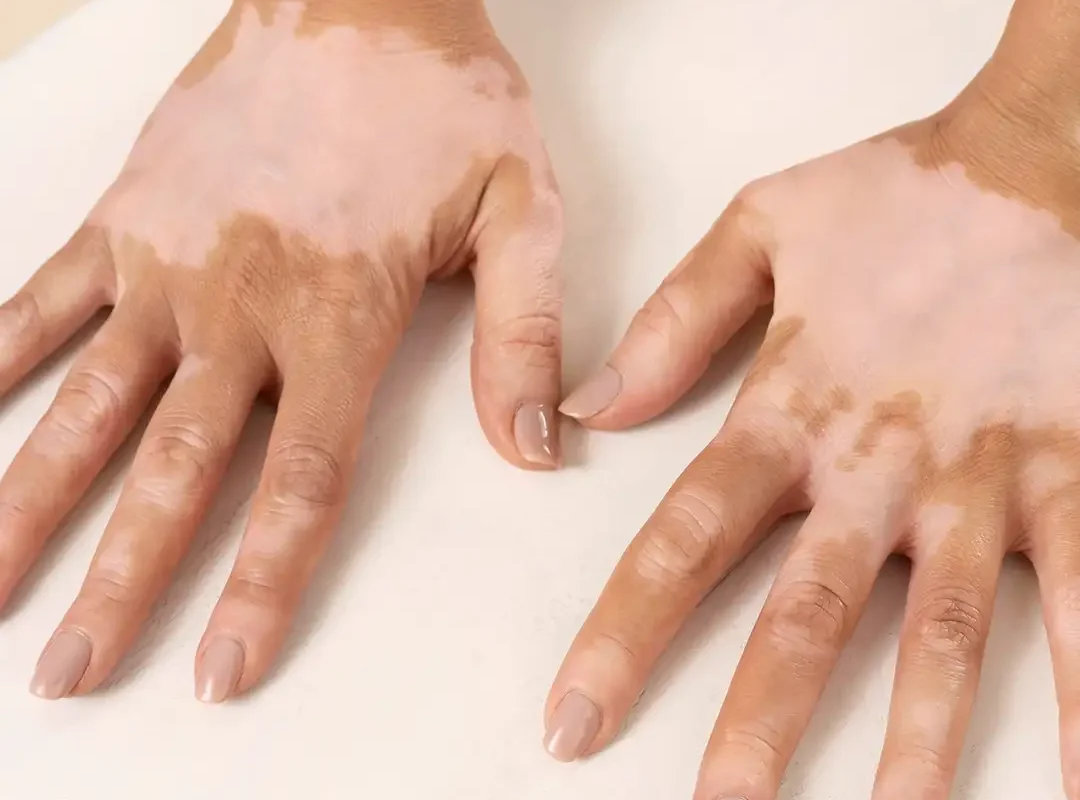
Vitiligo / White Spot Treatment in India
Vitiligo, characterized by white spots on the skin due to loss of pigmentation, is treatable in India through various advanced medical approaches. Renowned dermatology clinics offer treatments like topical corticosteroids, phototherapy (PUVA and UVB), and surgical options such as skin grafting or melanocyte transplantation.
What is Vitiligo or White Spot?
White Spot or Vitiligo (pronounced “vit-il-EYE-go”) is a skin condition that results in the loss of pigmentation of the skin, resulting in white patches that feel as if it is part of the skin. The exact cause of vitiligo is not clear, but it is believed to be an autoimmune disease, which means that there is an abnormal immune response to the normal body parts. Sometimes, trauma to the skin can also result in the development of vitiligo. Vitiligo (leukoderma/white spot) generally affects the face, hands & feet, elbows, and genital area.
These white patches of Vitiligo appear on different parts of the body because melanocytes (the cells that are responsible for forming melanin pigment) of the skin are destroyed or stop functioning. The effect is more striking and disfiguring in individuals with dark skin types (like we Indians).
Types of Vitiligo/White Spot
Types of vitiligo or white spot include:

Generalized
Most common, where patches appear on various parts of the body.

Segmental
This has an impact on one side of the body.

Focal
Focal vitiligo is a type with small and isolated patches.

Acrofacial
Affects body parts like fingers, toes, face, and lips.

Universal
This is a rare vitiligo type where most of the body part loses its pigment.

Mucosal
Mucosal vitiligo impacts your mucous membranes like lips, genitals, or inside the mouth.
Treatment for Vitiligo
There are 3 types of treatment for Vitiligo:

1. Medical Treatment
using immune-modulating drugs like systemic and topical corticosteroids, minocycline, levamisole, Calcineurin Inhibitors like Tacrolimus, and Vitamin-D like Calcipotriol supplementation. Results achieved with medical treatment are not predictable or permanent and unsatisfactory.

2. Light-based Vitiligo Therapy
PUVA and NB-UVB phototherapy to the whole body or targeted phototherapy by Excimer lasers. These therapies generally cause patchy or dotted repigmentation which may be unacceptable cosmetically.

Surgical
Surgical treatment of Vitiligo/White spot/ Leukoderma aims at bringing back natural color to white patches, which are resistant to conventional therapies. It is done by either complete skin transfers as Split Thickness Skin Grafts from healthy, pigmented areas or by using the latest black pigmentation transplantation technique called “Non-cultured Melanocyte transfer”, which is available at Saraswat Hospital, Agra for the first time in Agra region.
FAQs (Frequently Asked Questions):
Vitiligo surgery aims to restore normal pigmented skin through surgical means, which can be:
- Complete Skin Transfers: by suction blister grafting/punch grafting/sheet grafting.
- Pigment Cell transplant/transfer: It is called a “non-cultured melanocyte (or epidermal) suspension” transplant. This is the latest and also the most effective treatment for stable vitiligo patches. We have a special Lab for this procedure at Saraswat Hospital and it is giving results as per the International Standards. It achieves nearly complete repigmentation of the skin in 70-90% of patients.
Stable Patches not spreading for the past 3-6 months are treatable by Non-cultured Melanocyte transfer. Even large areas of white patches can be treated by this method.
The procedure is done under either Local Anaesthesia or General Anesthesia.
The procedure is done under either Local Anaesthesia or General Anesthesia.
The duration of the surgery depends upon the size of the area being treated. Usually, it takes 2-3 hours. The dressing is removed after 7 days.
The earliest pigmentation starts within 4 weeks of surgery and the significant repigmentation is noticed in 3-5 months.
Yes, it is a type of Plastic & Cosmetic surgery. In this procedure, after taking skin from the healthy donor area of the body, its epidermal layer containing melanocytes is separated using various solutions; and then this non-cultured melanocytic suspension is transplanted over the dermabraded depigmented site.
No, dietary restrictions are required for this treatment.
Non-cultured melanocyte suspension transplantation is a very safe treatment for stable Vitiligo. It has no significant side effects, provided it is done by a fully trained and expert Plastic & Cosmetic surgeon like Dr. Satya Saraswat and done at a proper Operation Theatre after taking all aseptic precautions. At present it is the most advanced treatment available for Vitiligo.

Certifications & Partnerships







The Saraswat Hospital Credentials

17000 +
Happy Clients

20 +
Years of Experience
98%
Hair Growth Rate

1500 +
Cases of Grade 5/6

4.9
Google Ratings
EXCELLENTTrustindex verifies that the original source of the review is Google. Best place in agra for skin and hair treatment.Trustindex verifies that the original source of the review is Google. Best centre for hair treatment in agra. Thank you sir and team.Trustindex verifies that the original source of the review is Google. It was very nice experience at the Saraswat Hospital,Agra. Polite and caring staff. Always available. Dr sir feels like our family member. Neat and clean rooms. Been there for son's cleft lip surgery. Fully satisfied with the results.Trustindex verifies that the original source of the review is Google. India no. 1 hair transplant clinic. Excellent team work and very helpful doctors.Trustindex verifies that the original source of the review is Google. Overall experience 2 year is good and staff behaviour also good. Thnk you Dr Saraswat and team.Trustindex verifies that the original source of the review is Google. It's very good clinic and very good service.Trustindex verifies that the original source of the review is Google. It has been great experience not only with the treatment but also with the overall service right from the reception to the doctor.Trustindex verifies that the original source of the review is Google. Had my first session of PRP today and it went great. Overall it was a wonderful experience...Verified by TrustindexTrustindex verified badge is the Universal Symbol of Trust. Only the greatest companies can get the verified badge who has a review score above 4.5, based on customer reviews over the past 12 months. Read more

